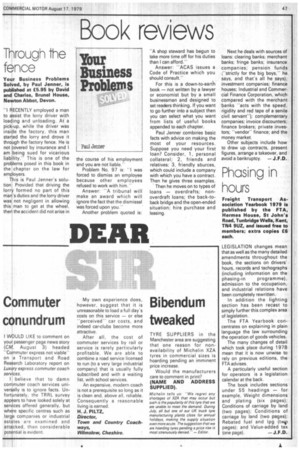Through f no
Page 49

If you've noticed an error in this article please click here to report it so we can fix it.
Yo Ur Business Problems Sol ed, by Paul Jenner, is published at £5.95 by David and Charles, Brunel House, Ne on Abbot, Devon.
"I ECENTLY employed a man to assist the lorry driver with loa ing and unloading. At a pic up, while the driver was insise the factory, this man star ed the lorry and drove it thro gh the factory fence. He is not overed by insurance and I am being sued for vicarious liab lity." This is one of the pro lerns posed in this book in the chapter on the law for em loyers.
This is Paul Jenner's solution Provided that driving the lorr formed no part of this ma 's duties and the lorry driver was not negligent in allowing this man to get at the wheel, the the accident did not arise in the course of his employment and you are not liable."'
Problem No. 97 is: -1 was forced to dismiss an employee because other employees refused to work with him."
Answer: "A tribunal will make an award which will ignore the fact that the dismissal was forced upon you .''
Another problem quoted is.
"A shop steward has begun to take more time off for his duties than I can afford.'"
Answer: -ACAS issues a Code of Practice which you should consult."
For this is a down-to-earth book — not written by a lawyer or economist but by a small businessman and designed to set readers thinking. If you want to go further into a subject then you can select what you want from lists of useful books appended to each chapter.
Paul Jenner combines basic facts with advice on making the most of your resources. Suppose you need your first loan? Consider, 1, personal collateral; 2, friends and relatives; 3, friendly sOurces, which could include a company with which you have a contract. Then he gives three examples.
Then he moves on to types of loans — overdrafts; nonoverdraft loans; the back-toback bridge and the open-ended situation; hire purchase and leasing. Next he deals with sources of loans: clearing banks; merchant banks; fringe banks; insurance companies; pension funds "strictly for the big boys," he says, and that's all he says); investment companies; finance houses; Industrial and Commercial Finance Corporation, which compared with the merchant • banks "acts with the speed, rigidity and red tape of a senile civil servant"); complementary companies; invoice discounters; finance brokers; private investors; "vendor" finance; and the money market.
Other subjects include how to draw up contracts, present figures, arrange a takeover, and avoid a bankruptcy. — J.F.D.








































































































